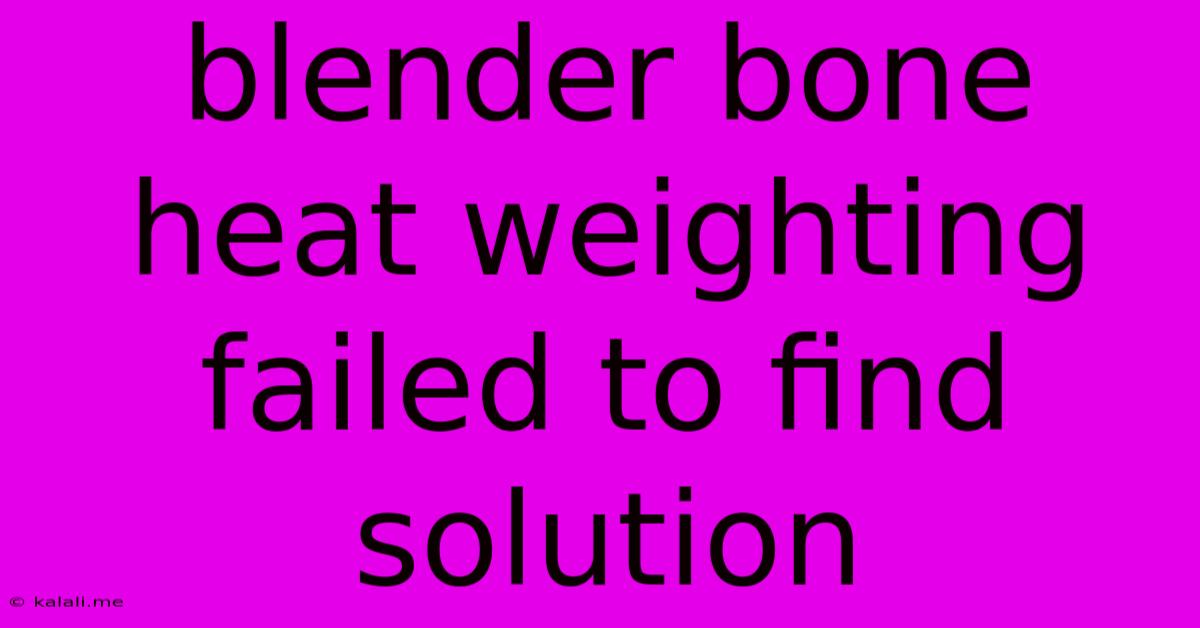Blender Bone Heat Weighting Failed To Find Solution
Kalali
Jun 06, 2025 · 3 min read

Table of Contents
Blender Bone Heat Weighting Failed: Troubleshooting and Solutions
Many Blender users encounter the frustrating "Bone Heat Weighting failed" error message when attempting to assign weights to vertices. This often occurs during rigging, preventing proper skin deformation and animation. This article dives into the common causes of this issue and provides practical troubleshooting steps to get your rigging back on track. Understanding the underlying causes will empower you to prevent this problem in future projects.
Understanding Bone Heat Weighting
Before diving into solutions, let's briefly understand what bone heat weighting does. It's a powerful tool in Blender that automatically assigns weights to vertices based on their proximity to bones. This process simulates heat diffusion, hence the name. Vertices closer to a bone receive higher weights, influencing how they deform when the bone moves. When it fails, it means the algorithm couldn't successfully calculate these weights.
Why Bone Heat Weighting Fails:
Several factors can lead to the "Bone Heat Weighting failed" error:
-
Mesh Topology Issues: This is the most common culprit. Problems like non-manifold geometry, overlapping vertices, extremely thin faces, and poorly connected geometry can confuse the weighting algorithm. Remember that clean topology is crucial for successful rigging.
-
Bone Arrangement: Incorrectly placed or overlapping bones can hinder the weighting process. Ensure bones are properly arranged and don't intersect unnecessarily. Consider simplifying your bone structure if it's overly complex.
-
Weighting Constraints: If you've already applied other weight painting modifications or constraints before attempting heat weighting, this might create conflicts that prevent the algorithm from completing its calculations.
Troubleshooting Steps:
Let's tackle how to resolve this frustrating error:
1. Inspect Your Mesh:
-
Check for Non-Manifold Geometry: Use Blender's tools to identify and fix any non-manifold geometry. This usually involves merging or deleting problematic vertices or edges. The "Select Non-Manifold" function in the selection menu is invaluable here.
-
Remove Overlapping Vertices: The algorithm can't process overlapping vertices accurately. Use the Merge by Distance function to eliminate any duplicate or very close vertices.
-
Examine Face Quality: Look for extremely thin or distorted faces. Remeshing the mesh or using a subdivision surface modifier can often alleviate this issue.
-
Ensure Proper Connectivity: Verify that all parts of your mesh are properly connected. Disconnected components will fail to weight correctly.
2. Review Your Armature:
-
Simplify Bone Structure (if possible): A highly complex armature can sometimes lead to weighting problems. If feasible, simplify the bone structure by combining or removing unnecessary bones.
-
Check for Bone Overlap: Make sure your bones don't overlap significantly. Adjust bone positions to avoid interference.
-
Check Parent/Child Relationships: Ensure your armature bones are correctly parent-linked and organized. Any issues here can propagate up to the weighting stage.
3. Weighting Process Adjustments:
-
Clean Weight Paint: Before attempting Heat Weighting, remove any existing weights or try deleting the existing vertex groups that you have. Start fresh.
-
Adjust Heat Weighting Parameters: Experiment with the "Heat" and "Weight" parameters in the Bone Heat Weighting operator's settings. Sometimes subtle adjustments can make a difference.
-
Alternative Weighting Methods: If heat weighting continues to fail, explore alternative methods such as manual weight painting or using a different weighting method provided by Blender.
4. Retopology:
In some cases, particularly with high-poly models, retopology is the best solution. Create a lower-polygon mesh with cleaner topology, then transfer the weights from the high-poly to the low-poly model.
Prevention is Key:
The best approach is preventative. Maintaining clean topology throughout your modeling process minimizes the likelihood of encountering this error. Pay close attention to your mesh's cleanliness, particularly when creating organic models where topology directly affects weighting performance.
By systematically addressing these points, you should be able to resolve the "Bone Heat Weighting failed" error and proceed smoothly with your rigging workflow. Remember that patience and a methodical approach are key to troubleshooting complex Blender issues.
Latest Posts
Latest Posts
-
Toilet Bubbles When Flushed But Not Clogged
Jun 07, 2025
-
When To Use Gear 1 And 2 In Automatic
Jun 07, 2025
-
Rebellion Is A Sin Of Witchcraft
Jun 07, 2025
-
How To Check Affinity Fallout 4
Jun 07, 2025
-
Can I Put Water In My Coolant
Jun 07, 2025
Related Post
Thank you for visiting our website which covers about Blender Bone Heat Weighting Failed To Find Solution . We hope the information provided has been useful to you. Feel free to contact us if you have any questions or need further assistance. See you next time and don't miss to bookmark.